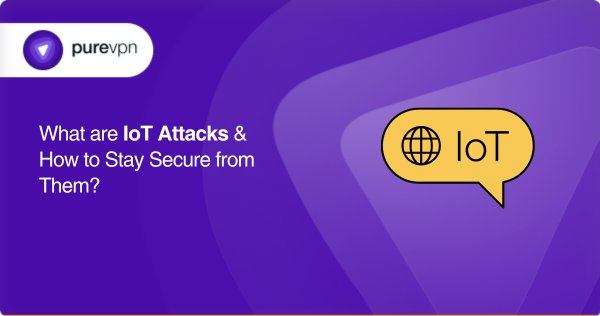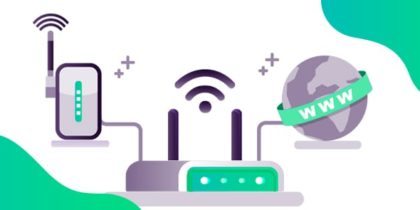Table of Contents
The Internet of Things (IoT) has changed the way we live and work, connecting 66% of total gadgets to the Internet to make our lives convenient and efficient. However, with this convenience comes the potential threats of IoT attacks.
37% of IoT malware is recorded globally inside the first six months of 2023, reporting a total of 77.9 million attacks in comparison to 57 million in the first half of 2022.
In this blog, we’ll discuss what are IoT attacks, why they are first-level security risks, and most importantly, how to stay secure from these IoT attacks.

What are IoT (Internet of Things) Attacks?
IoT (Internet of Things) attacks are harmful activities that exploit vulnerabilities in interior IoT gadgets, networks, or ecosystems. IoT attacks have come to be significant because of the increase in interconnected devices in homes, agencies, and industries.
The attacker uses special techniques for these attacks so it is better to learn about them before any data breach. Here is a list of several IoT attacks:
Botnet Attacks
In a Botnet attack, cybercriminals compromise many IoT devices, including routers, cameras, or smart appliances, and use them to shape a community of bots (zombie devices).
These botnets may be harnessed to release numerous malicious activities through Distributed Denial of Service (DDoS) attacks, records theft, or unsolicited mail campaigns. One of the most notorious examples of this type of attack is the Mirai botnet.
Device Hijacking
Device hijacking involves attackers gaining unauthorized control over IoT devices that could vary from smart locks and thermostats to scientific devices.
Once compromised, attackers may additionally control tool functions, steal sensitive data, or use the device for similar attacks.
It happens by regularly exploiting weak passwords or protection vulnerabilities in the devices.
Data Breaches
IoT devices regularly collect and transmit sensitive statistics, including personal information or video feeds.
Attackers may also target these gadgets to gain access to this sensitive information, leading to security breaches and privacy violations.
For instance, a compromised digital camera can bring about unauthorized access to live video streams.
Man-in-the-Middle (MitM) Attacks
In MitM attacks, the attacker acts as an intermediate user and changes data exchanged among IoT gadgets and their servers or different devices.
Attackers can listen in on communications, scouse, borrow information, or inject malicious code into data transmissions.
Physical Attacks
Physical attacks on IoT devices contain physically manipulating the data to cause harm. This can encompass disabling safety capabilities, altering firmware, or compromising the tool’s integrity.
Ransomware
In IoT ransomware attacks, attackers encrypt the data saved on IoT gadgets and demand a ransom for decryption. It can affect vital systems like business control structures or healthcare devices.
Supply Chain Attacks
Attackers can also compromise IoT devices at some stage in production or distribution, embedding malware or vulnerabilities into the gadgets before they reach the end users.
RFID Attacks
RFID (Radio-Frequency Identification) attacks exploit vulnerabilities in RFID systems to gain unauthorized access to records or places. These attacks can occur in access control systems, asset tracking, and payment systems.
Zero-Day Exploits
Attackers can also find out and make the most formerly unknown vulnerabilities (0-day vulnerabilities) in IoT devices or their software programs, taking advantage of the fact that there are no recognized patches to shield against those attacks.
Eavesdropping and Data Interception
Attackers may intercept and listen in on communications among IoT gadgets, gathering sensitive records or gaining insights into user behaviors and conduct. To defend against IoT attacks, individuals and agencies should prioritize IoT safety.
This consists of converting default passwords, preserving firmware and software updates, segmenting IoT networks, implementing firewalls, carrying out security assessments, and staying informed about emerging threats and vulnerabilities within the IoT landscape.
Why are IoT Attacks a Concern?
Suppose you have installed a camera for surveillance in your house. The worker claims only you can access it, but that’s not true. Your camera uses an IP address to connect to the device in which you monitor.
This IP address can easily be accessed by hackers, who can use your information for their malicious intentions. That’s why security is the highest priority for IoT devices. Below, we’ll explore several more reasons why IoT is a concern:
Security Vulnerabilities
IoT gadgets are designed for comfort and to make life faster and easier. But it also becomes a nightmare with weak security, including default passwords, lack of safety software updates, and vulnerable authentication mechanisms.
Privacy Risks
IoT gadgets acquire large amounts of data about users’ behaviors, choices, and workouts. This information can be exploited if not adequately protected, leading to privacy violations and issues about unauthorized access and sharing.
Cyberattacks and Malware
IoT gadgets are the foremost targets of cyberattacks, which include botnet infections, ransomware attacks, and information breaches. When compromised, those devices can be weaponized to launch attacks on different systems or networks.
Physical Safety
If you are using IoT devices to manage physical systems, including smart motors, commercial control systems, data breaches can have physical outcomes, probably endangering lives.
Interoperability Challenges
Every manufacturer of IoT devices may not be interoperable due to compatibility troubles and safety gaps when integrating multiple devices into a single environment.
Supply Chain Vulnerabilities
IoT gadgets regularly have complex supply chains, making them at risk of chain attacks where hackers compromise devices during production or distribution.
Lack of Standardization
The lack of a standardized IoT protection framework can bring about inconsistencies in security practices and make it hard for users to evaluate the safety of the devices they purchase.
Societal Implications
IoT is increasingly included in important infrastructure, healthcare, transportation, and smart cities. Security vulnerabilities in those structures could have far-attaining societal outcomes, affecting public protection and essential platforms.
How to Stay Safe from IoT Attacks
Securing your IoT (Internet of Things) environment is crucial to defend your devices, records, and privacy from potential threats. Here are simple steps to ensure your IoT gadgets and networks:
Change Default Passwords
One of the common weaknesses in IoT gadgets is the use of default passwords. Always change default usernames and passwords to strong, unique combos. Consider the usage of a password manager to generate and store credentials securely.
Firmware and Software Updates
Regularly check firmware and software updates prompted by the manufacturer. These updates consist of security patches to address acknowledged vulnerabilities.
Network Segmentation
Isolate your IoT devices in a separate network. This separation prevents attackers from exploiting your other devices.
Firewalls
Configure firewalls to filter incoming and outgoing traffic of IoT devices. Firewalls can help block malicious traffic and unauthorized access.
Intrusion Detection Systems (IDS)
Implement intrusion detection structures to screen network visitors and identify unusual or probably malicious activity. IDS can alert you to potential threats in actual time.
Authentication
Enable strong authentication methods consisting of multi-factor authentication (MFA). This provides a further layer of protection to shield your gadgets and accounts.
Privacy Settings
Review and regulate privacy settings for your IoT devices—Disable needless data collection and sharing features to reduce the data uncovered to potential attackers.
Zero Trust Model
Adopt a zero-consider approach, which means trusting nothing by default. Continuously verify the authenticity and security of gadgets and customers before granting access.
Manufacturer Reputation
Choose IoT devices from professional producers with a record of prioritizing security. Do your studies to determine whether a producer offers updates and help daily.
Regular Backup
Back up any crucial information generated or saved via your IoT gadgets. In case of a protection incident or records loss, having backups can be helpful.
Securing your IoT environment requires a proactive and multi-layered method. By imposing these security features and staying vigilant, you can reduce the chance of IoT-related safety incidents and shield your linked surroundings.
Quickest Way to Secure Your IoT Environment
With hundreds of security tools available on the market for securing IoT devices, you might be confused about which one is the best and provides all features in a single package.
Well, there is no need to search dozens of websites. Try using a VPN that consists of multiple features like PureSquare.
PureSquare is a package of the best security teams, including PureVPN, PureEncrypt, PureKeep, and PurePrivacy. Here are some benefits of using PureSquare:
- You can easily apply strong encryption of AES-256-bit on your IoT devices with PureEncrypt.
- Change default passwords into strong and complex ones and store them in a private tool, PureKeep.
- Make your IoT devices invisible on the Internet, which means getting a private network with PurePrivacy.
- Access 6500+ servers and overcome geo-restrictions by changing your IP address with PureVPN.
- PureVPN also comes with a no-log policy, which means your online activity will not have any history stored in the VPN that protects you from many scammers and clickbait.
What are the types of IoT security?
There are three main types of IoT security including: network security, Embedded systems,m security, and Firmware security.
- In network security, you need to protect devices against unauthorized access and potential attacks.
- IoT devices work through embedded systems like Raspberry Pi. These nanodevices need protection so hackers cannot corrupt their coding.
- Firmware security starts with monitoring the firmware used for IoT devices to detect potential vulnerabilities.
What is the biggest risk of IoT?
The primary vulnerability in IoT security is the absence of encryption for regular data transmissions. Many IoT gadgets neglect to encrypt the records they transmit.
Consequently, if an unauthorized user gains access to the network, they can intercept crucial data credentials exchanged between your IoT devices.
What are IoT devices?
Appliances that are connected to the Internet, including dishwashers, refrigerators, smart TVs, smart watches, cars and trucks, heating and cooling systems, fitness machines, and trackers, are examples of IoT products.
IoT: Securing a Connected Future
As IoT devices continue to evolve and are expected to reach 25.4 billion by 2030, it’s essential to understand the potential risks associated with connected devices and take precautions to protect yourself and your network.
By following best security practices for protecting IoT devices and staying vigilant, you can enjoy the benefits of IoT technology while reducing the risks of IoT attacks in our ever-connected world.



